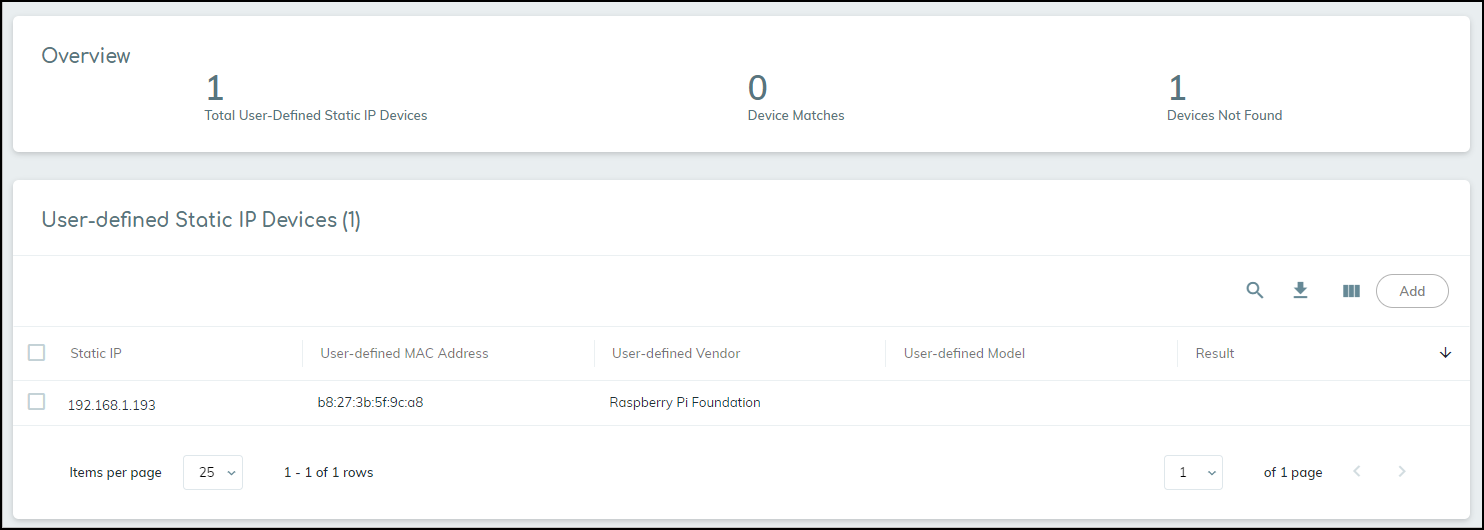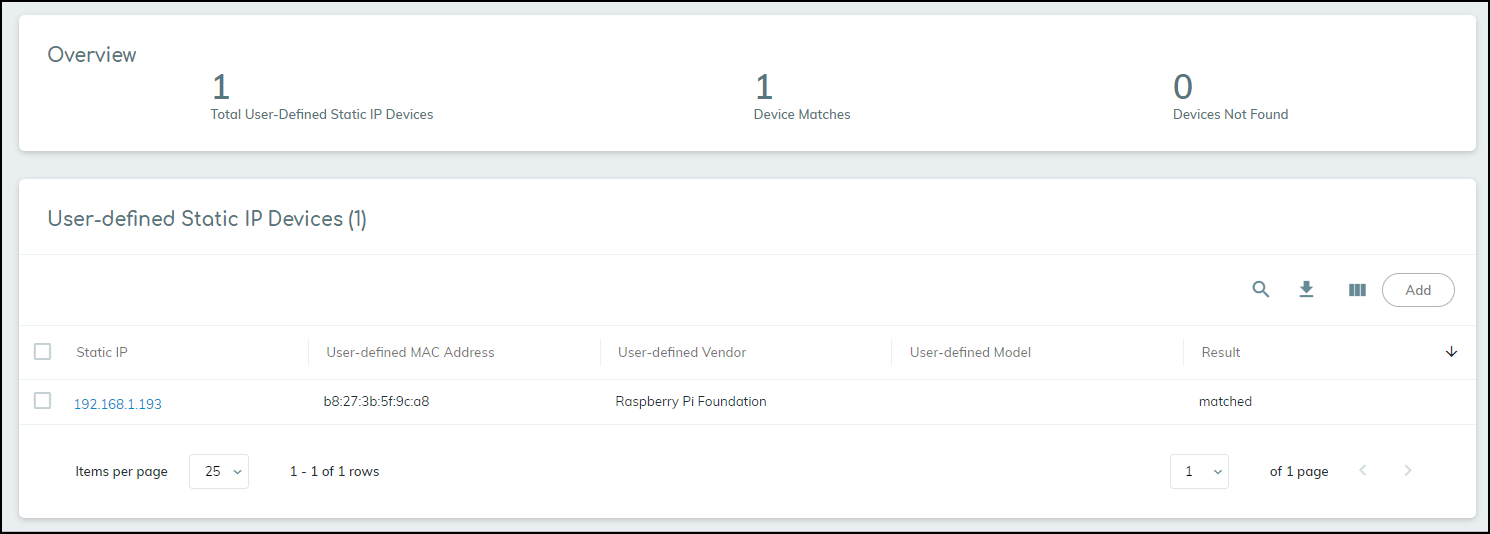Device Security
Add a Static IP Device Configuration
Table of Contents
Expand All
|
Collapse All
Device Security Docs
Add a Static IP Device Configuration
Add static IP devices to Device Security by manually configuring them.
| Where Can I Use This? | What Do I Need? |
|---|---|
|
One of the following subscriptions:
|
Instead of uploading a CSV file with a list
of static IP devices (see Upload a List of Static IP Devices), you can
add them individually.
Strata Cloud Manager
Add static IP devices to Device Security in Strata Cloud Manager by manually
configuring them.
- Navigate to AssetsUser-Defined Static IP Devices and then click AddManually Add a Static IP Device.Define a static IP device and then click Add.IP Address: Enter the static IP address of the device you want to add to your inventory. The IP address is what Device Security uses to track user-defined static IP devices.MAC Address (optional): If you want, add the MAC address of the device in hexadecimal notation. Device Security accepts any of the following MAC address formats:aa:bb:cc:00:11:22AA:BB:CC:00:11:22aa.bb.cc.00.11.22AA.BB.CC.00.11.22aa-bb-cc-00-11-22AA-BB-CC-00-11-22aa bb cc 00 11 22AA BB CC 00 11 22aabbcc001122AABBCC001122If the user-defined MAC address is different from the MAC address Device Security detects on the network, the detected MAC address overrides the user-defined one. If Device Security does not detect a MAC address, the user-defined MAC address appears on the Devices and Device Details pages.Vendor (optional): Enter the vendor for this device.Model (optional): Enter the device model.The vendor and model attributes provide extra information when referring to entries on the User-Defined Static IP Devices page later. However, they do not appear on the Devices and Device Details pages.Click Add to add the configuration to Device Security and then click OK to close the confirmation message that appears.
![]() After you add the static IP device, Device Security initially treats it as “not found”. It incrementally increases the Total User-Defined Static IP Devices counter by one and the Devices Not Found counter by one. Although it adds an entry for it to the User-Defined Static IP Devices list, the Result column remains empty – there isn’t a “matched” entry, indicating that Device Security detected network activity for this IP address, or a dash, indicating that no such activity was detected.
After you add the static IP device, Device Security initially treats it as “not found”. It incrementally increases the Total User-Defined Static IP Devices counter by one and the Devices Not Found counter by one. Although it adds an entry for it to the User-Defined Static IP Devices list, the Result column remains empty – there isn’t a “matched” entry, indicating that Device Security detected network activity for this IP address, or a dash, indicating that no such activity was detected.![]() Because Device Security periodically compares entries in the user-defined static IP devices list with those in its inventory and its internal database of detected IP addresses without accompanying MAC addresses, the page can remain in this initial state for several minutes.If a match is found, the Device Matches counter increases by one and the Devices Not Found counter decreases by one. Also, “matched” now appears in the Result column.
Because Device Security periodically compares entries in the user-defined static IP devices list with those in its inventory and its internal database of detected IP addresses without accompanying MAC addresses, the page can remain in this initial state for several minutes.If a match is found, the Device Matches counter increases by one and the Devices Not Found counter decreases by one. Also, “matched” now appears in the Result column.![]() If Device Security does not find a match, it eventually displays a dash in the Result column.You might have to reload the User-defined Static IP Devices page to see the updated data.
If Device Security does not find a match, it eventually displays a dash in the Result column.You might have to reload the User-defined Static IP Devices page to see the updated data.
(Legacy) IoT Security
Add static IP devices to Device Security by manually configuring them.
- Navigate to the User-defined Static IP Devices page (AssetsDevicesUser-Defined Static IP Devices) and then click AddManually Add a Static IP Device.Define a static IP device and then click Add.IP Address: Enter the static IP address of the device you want to add to your inventory. The IP address is what Device Security uses to track user-defined static IP devices.MAC Address (optional): If you want, add the MAC address of the device in hexadecimal notation. Device Security accepts any of the following MAC address formats:aa:bb:cc:00:11:22AA:BB:CC:00:11:22aa.bb.cc.00.11.22AA.BB.CC.00.11.22aa-bb-cc-00-11-22AA-BB-CC-00-11-22aa bb cc 00 11 22AA BB CC 00 11 22aabbcc001122AABBCC001122If the user-defined MAC address is different from the MAC address Device Security detects on the network, the detected MAC address overrides the user-defined one. If Device Security does not detect a MAC address, the user-defined MAC address appears on the Devices and Device Details pages.Vendor (optional): Enter the vendor for this device.Model (optional): Enter the device model.The vendor and model attributes provide extra information when referring to entries on the User-Defined Static IP Devices page later. However, they do not appear on the Devices and Device Details pages.Click Add to add the configuration to Device Security and then click OK to close the confirmation message that appears.
![]() After you add the static IP device, Device Security initially treats it as “not found”. It incrementally increases the Total User-Defined Static IP Devices counter by one and the Devices Not Found counter by one. Although it adds an entry for it to the User-Defined Static IP Devices list, the Result column remains empty – there isn’t a “matched” entry, indicating that Device Security detected network activity for this IP address, or a dash, indicating that no such activity was detected.
After you add the static IP device, Device Security initially treats it as “not found”. It incrementally increases the Total User-Defined Static IP Devices counter by one and the Devices Not Found counter by one. Although it adds an entry for it to the User-Defined Static IP Devices list, the Result column remains empty – there isn’t a “matched” entry, indicating that Device Security detected network activity for this IP address, or a dash, indicating that no such activity was detected.![]() Because Device Security periodically compares entries in the user-defined static IP devices list with those in its inventory and its internal database of detected IP addresses without accompanying MAC addresses, the page can remain in this initial state for several minutes.If a match is found, the Device Matches counter increases by one and the Devices Not Found counter decreases by one. Also, “matched” now appears in the Result column.
Because Device Security periodically compares entries in the user-defined static IP devices list with those in its inventory and its internal database of detected IP addresses without accompanying MAC addresses, the page can remain in this initial state for several minutes.If a match is found, the Device Matches counter increases by one and the Devices Not Found counter decreases by one. Also, “matched” now appears in the Result column.![]() If Device Security does not find a match, it eventually displays a dash in the Result column.You might have to reload the User-defined Static IP Devices page to see the updated data.
If Device Security does not find a match, it eventually displays a dash in the Result column.You might have to reload the User-defined Static IP Devices page to see the updated data.



